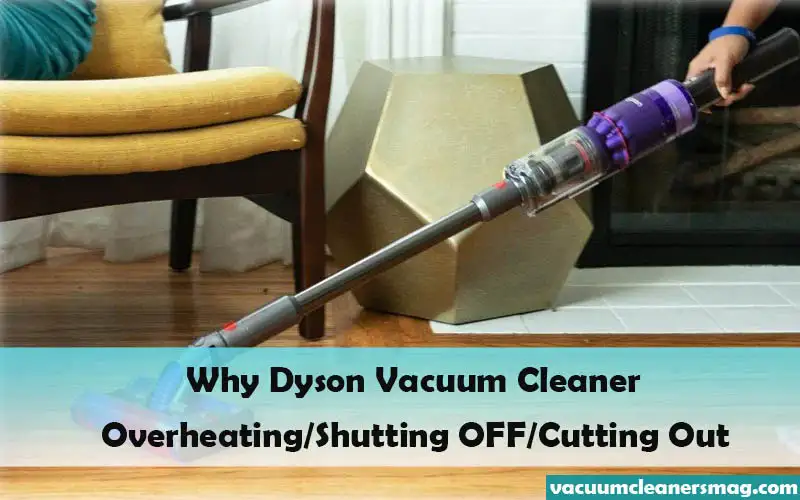Dyson vacuums are excellent tools for cleaning your home, but because of their complexities, trying to fix their problems can be very frustrating. Your vacuum cleaner can start smoking(due to overheating), make odd noises, smell burnt, turn off suddenly, or might cut off from voltage supply.
These are the few indications that your vacuum cleaner is past its prime and is overheating. Simply put, your vacuum is not working correctly or at all.
The good news is that there are a few useful things you can try to fix an overheated cleaner yourself and prevent it from happening again so you can have a properly functioning vacuum cleaner in your home.
Keep reading to understand why your Dyson vacuum is overheating & keeps cutting out and how to fix this issue.
Why does my Dyson Vacuum keep Shutting OFF?
The vacuum cleaner might keep cutting out while in use as a result of a broken vacuum hose, a clogged motor air filter, or a defective suction motor.
A tripped overload on the suction motor can also turn off the vacuum cleaner while it is functioning.
Push the reset button on your vacuum if it has one; if it appears hot, let it cool off first.
Since some Dyson vacuums have a thermal cut-off safety feature, they will turn off by themselves to avoid harm from overheating.
What happens when a Dyson Vacuum Overheats?
A Dyson cleaner overheats when a malfunction in one of its components forces the motor to work harder than usual.
When the engine gets hotter than normal, the vacuum often shuts off by itself. This is due to the fact that it receives little to no airflow to help it cool down.
After all, there is a blockage preventing the air from moving and then causing the vacuum to overheat and shut off.
Why my Dyson vacuum is Overheating?
Here are a few reasons why your Dyson may be overheating:
Dirty Filters
Any vacuum, whether a canister vacuum or a cordless stick vacuum. Even if it includes one or more filters, when the filters get clogged with dust and debris, the airflow is reduced.
Clogged filters may also cause the vacuum to turn off automatically while functioning, which can be quite frustrating when you’re cleaning.
Filthy Cyclone Assembly
The risk of overheating is increased when there is too much dust inside the cyclone system. This dirt can slow down the vacuum and make the motor work harder than usual.
In addition to a buildup of dust, the cyclone assembly’s worn-out seals can reduce airflow, making the vacuum work harder to clean different surfaces.
Clogged Brush Bar
The vacuum might heat up if the motor tries to spin the brush rollers at the bottom of the vacuum if they are not rotating easily.
The most common source of issues with the brush bar is jammed-up roller brushes, a broken belt, or, in the worst case, a malfunctioning motor, which can also slow down the vacuum and lead to overheating.
Faulty Interiors
It’s likely that some of the components in your Dyson vacuum are worn out and need to be replaced.
In most cases, cleaning your vacuum might solve the problem. But if the issue continues, the vacuum’s internal mechanism might be broken.
The first place to look if your vacuum is acting up should be the engine, which will emit an excessive amount of heat in such a case.
How do I Fix my Dyson Vacuum that’s Overheating?
Here’s a simple guide to fixing your Dyson overheating issues:
Clean Out the Dust Bag
If your vacuum uses a dirtbag or a canister, it needs to be replaced when it is approximately 75% full.
If you don’t, the bag may fill up too much. There is nowhere for the dust and grime to move when this occurs. As a result, it travels inside the vacuum and prevents the machine from collecting more debris.
The trash can wind up blocking the appliance or accumulating on the engine. You can anticipate that the vacuum will eventually jam, overheat, and shut off. This is why it is ideal to clear up the dust bag after every use.
Check the Air Filter
The motor is likely to overheat if the air filter is blocked and not changed promptly. Depending on the model of your vacuum, wipe the air filter with a moist cloth or replace it to solve the problem. Allow the filter to thoroughly dry before reinstalling it in the cleaner.
It is better to consult your vacuum’s guidebook for the finest maintenance advice. Some filters can’t be washed, therefore you’ll have to replace them.
Maintaining the air filter will not only stop future overheating, but it will also help your Dyson last longer.
Check the Belt
While checking other important components, make sure to check the belt too. It’s possible that the belt has snapped, which is causing the motor to overheat.
This occurs when the belt is not in the appropriate position and the roller brush and belt are not providing any resistance to the motor.
Of course, overuse and aging can also cause belts to break over time. If nothing else has worked up to this point to stop the overheating, inspect the condition of the belt to see if it needs to be changed.
Check for Electrical Problems
First of all, check the vacuum’s cable. Examine the cord thoroughly for any signs of damage. Look for wires, breaks, cracks, and indentations. Buy a replacement cord instantly if you spot any damage at all. Till a new cord is installed to replace the damaged one, refrain from using the vacuum.
If the cord does not appear to have any outward damage and the outlet also seems to be functioning properly, there might be a larger problem at hand.
The motor’s performance could be impacted by any broken internal component which needs to be inspected by a professional.
Let the Dyson Cool Off
The motor won’t operate correctly when it’s heated. In fact, running a vacuum while it’s still hot could really harm the insides.
Try to restart the vacuum after it has totally cooled down. Hopefully, it will function normally. But if the vacuum still keeps overheating, there may be a more significant underlying problem that requires repair or inspection by an expert.
How do I Reset the Dyson Vacuum When Overheated
The thermal fuse is a self-reset feature that cuts off the vacuum’s power supply when senses overheating. That won’t occur, though, until the heated vacuum has completely cooled down.
Disconnecting the vacuum’s power source (wall socket or battery) and letting it cool for at least an hour will assist the thermal fuse in resetting.
You can start vacuuming again after the vacuum cools down and the thermal fuse resets itself.
Is it normal for the Dyson vacuum to get hot?
Overheating is typically not a problem with Dyson. These vacuum models have a safety feature that turns off the vacuum if the device begins to overheat.
It should come as no surprise that irregular cutting off is one of the warning signals of an overheated vacuum which can easily be inspected using the guide above.
Conclusion
Whether your Dyson is overheating, shutting down, or emitting smokes, there are measures you may take methodically to identify the source of these issues. You can now determine and resolve any problems related to Dyson vacuum cutting out and overheating through this article.

Hi Everyone.
I’m Safeer. I always loved trying out the latest cleaning and home products and sharing my thoughts about those products with you awesome people. Whether it’s related to general cleaning or it includes cleaning with high-tech vacuum cleaners, I always test them myself and then share valuable opinions with you. Additionally, I also let you know how to resolve particular issues of vacuum cleaners. To look for detailed reviews and troubleshooting tips about vacuum cleaners VaccumCleanersMag is the perfect abode for you.

